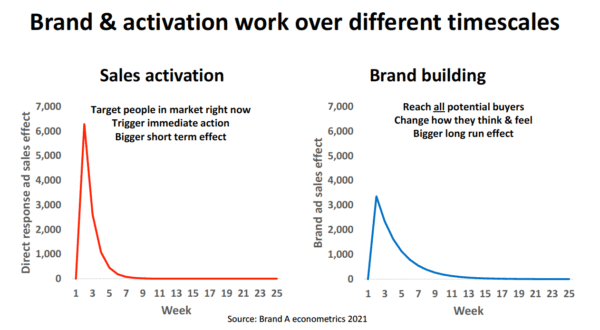Brand Building versus Sales Activation: A False Dichotomy?
January 24, 2023

By Les Binet- Group Head of Effectiveness / adam&eveDDB
Peter Field & I recommend that marketers use a mix of “brand building” & “activation” communications. Our researsuggests the optimum split is usually somewhere around 60% brand, 40% activation, but varies by category and context.
But why split brand and activation at all? Why not do both at once?
Definitions first. By “brand building” we mean building and maintaining memory structures that have a lasting influence on consumer behavior. By “activation” we mean activating existing memory structures to elicit immediate behavioral responses.
For example, a travel insurance firm selling to young people might sponsor a festival. If they do it well and get good exposure, they will slightly increase the chance that youngsters think of them (and think well of them) when they need travel insurance. That’s brand building.
The same firm might send email reminders to existing customers when it’s time to renew their policy. The aim here is not to change their perceptions of the brand, but to simply get them to click the “renew” button. That’s activation.

Brand and activation tend to work over different timescales. Activation tends to produce rapid responses, and if you get it right the effects can be quite dramatic. But those activation effects also tend to decay away rapidly. Brand building is harder and takes longer because you’re trying to change people’s minds, often at a time when they’re notBrand & activation work over different timescales.
Sales activation Brand building
But can’t you do both brand building and activation at the same time? Yes! In fact, all marketing activities tend to do a bit of both. That festival sponsorship may prompt a few immediate sales. That renewal reminder may improve brand image a bit if it’s well crafted. But some activities are better for brand building, others are better for activation. That reminder email may trigger lots of renewals, but the effect on brand memories will be small.
That sponsorship may improve brand image, but it won’t stimulate quite so many immediate sales.
But why are some activities good for brand building, while others are good for activation? Because these two jobs require different targeting, different content, and different responses.

Start with targeting. If you want an immediate response (“activation”), you need to focus on people who are likely to respond right now. But if you’re creating lasting memories (“brand building”) then the audience can be anyone who might buy in the next year or so, because of the way memories persist.
Targeting in turn affects attention. People who are shopping right now want information about products, prices and how to buy. But the broader pool of potential customers aren’t interested in those details yet. So you need to be more creative to get their attention.
Differences in targeting and attention mean that brand & activation need different content Activation should be interesting, informative & useful for shoppers. You need to keep it directly relevant to their shopping mission. But brand communications should be more generally interesting. You need to find a way to connect the product to your audiences’ broader needs and concerns.
Brand and activation comms use different targeting and different content to evoke different responses. Brand building creates lasting memories (that influence subsequent behavior). Activation provokes immediate action (without the need for long term memories).
So brand building needs to interesting, relevant & memorable for anyone who might buy the category one day. Activation needs to be interesting, persuasive, useful & actionable for the few who are shopping right now.
Brand should be creative, entertaining, and enjoyable. It works at the “System 1” level, using emotions and feelings to create associations.
Activation works at the “System 2” level, delivering relevant & useful information to help the customer to complete their shopping mission. Entertainment can be a distraction here and may not always be welcome.
This means that activation is often weak at brand building, and vice versa. The two activities require different targeting, different content, and are processed in different ways. It’s not impossible to do both at once, but evidence from the IPA Databank suggests that it is inefficient.

But you do need to include both activation and brand building in your marketing plan, because each makes the other work harder.
So separate the brand and activation strands of your marketing, making sure that people can connect the two quickly and easily. Consistency, strong branding, and clear relevance to the category help bind the whole thing together.
[By the way, I’m not suggesting that brand and activation should be managed separately. In fact, that’s probably not a good idea. I’m merely suggesting that different elements of your comms mix should focus on one job or the other.]
Once you’ve got your brand and activation comms sorted, you need to make sure that spend is balanced between them. Our “60:40 rule” is just a rough rule of thumb. Some firms need more activation, others need more brand.
Ideally, we recommend measuring precisely how your brand’s sales respond to brand and activation over the short- and long-term using econometrics (AKA Market Mix Modelling), and then using this information to optimisz your budgets.
But that’s a topic for another day…





























